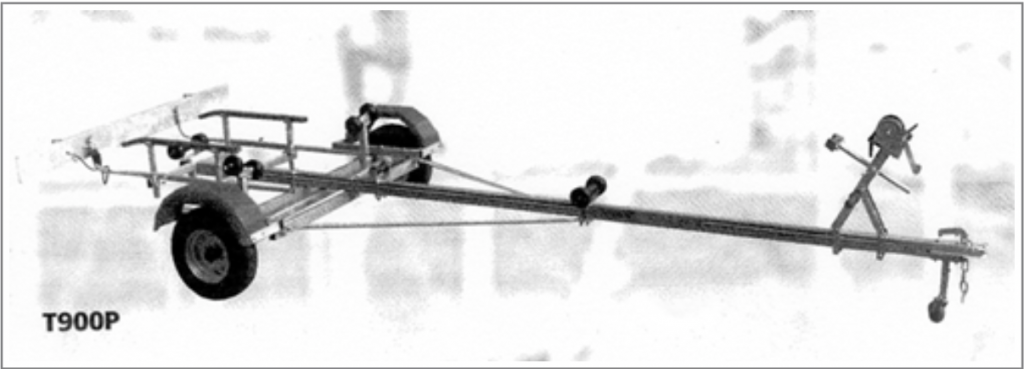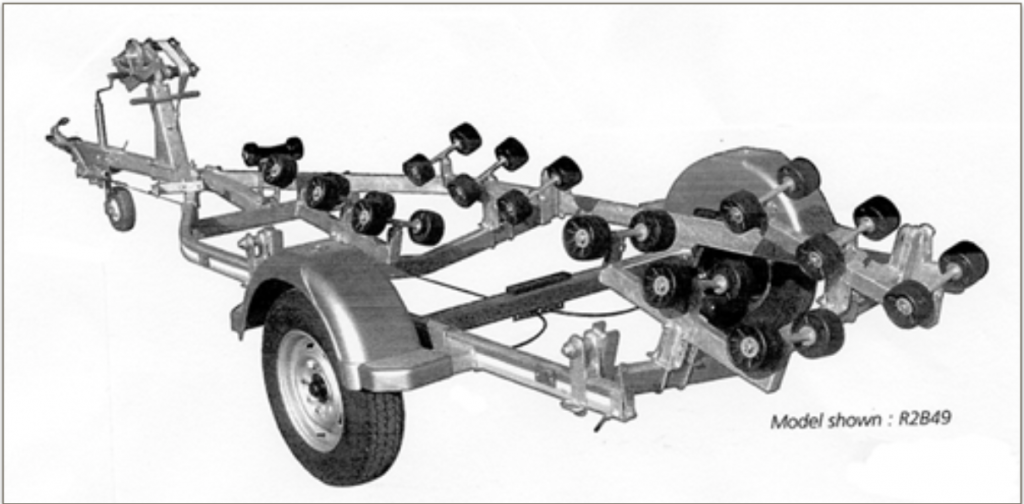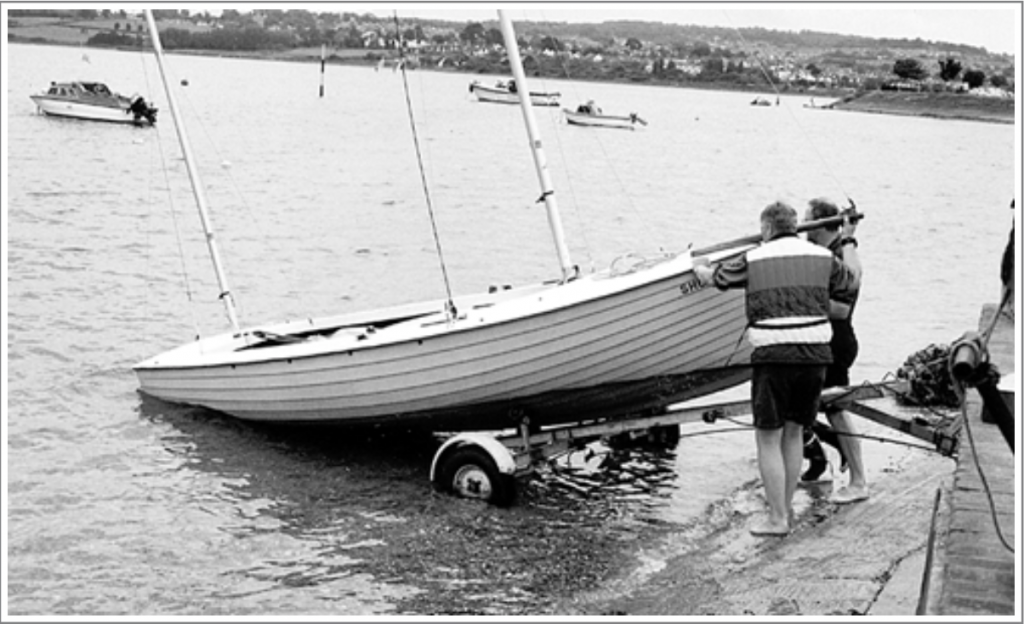TRAILERS
TRAILERS by Derek Gouldsworthy DY173 (this article was written in approx 2004)
Buying a trailer is not difficult. Understanding the current law governing their use and the plethora of Euro jargon around it is a bit more difficult. I started this article to help a fellow Yawler to replace his trailer. The following are my findings based on what a Yawl owner might need to know. I am indebted to Yachts & Yachting, who coincidentally produced an article on this subject in its April 23 edition and the web site of the National Trailer and Towing Association, both of which I have heavily relied upon. There is a disclaimer on any errors – you should check the information yourself for accuracy.
Before you start looking to buy, you need to know some basic facts:
Weight of the boat & trailer being towed and any equipment it will be carrying. Weight of the towing vehicle and the maximum permissible trailer weight it can tow. Trailer law.
Class Rules specifies that the Devon Yawl should have a minimum overall dry weight of 432kg. Few boats have been weighed let alone built specifically to this weight. For the purposes of this article, I have based it on my own boat, trailer (an old braked Metalcraft break-back) and equipment as they have been weighed:
| Boat (actual) | 470kg |
| Trailer | 170kg |
| Spars | 20kg |
| Total | 660kg |
N.B. Additional equipment of sails, rudder, cover, O/B and spare wheel would add a further 40kg.
The magic number for the all-up weight of a loaded trailer is 750kg. You can tow a maximum of 750kg with an UNBRAKED trailer but you cannot exceed half the kerb weight of the towing vehicle. You can tow a trailer with an all-up weight limit higher than your car’s towing limit as long as you only load the trailer up to the car’s towing limit. It is illegal to exceed the car’s towing limit.
It is legal for me to tow my Yawl with an UNBRAKED trailer with my Mondeo (KW 1375kg) provided I do not exceed a trailer weight of 687kg BUT if I used my wife’s Astra (KW 1172kg), I would be breaking the law with my rig as I should only have an all-up trailer weight of 586kg. I would need a BRAKED trailer to use the Astra.
Having decided whether it is to be a braked or unbraked trailer, there now comes the choice of trailer which fall into four categories:
Rigid ‘A’ or ‘T’ frame


Break-back
Multi-roller
Combi
Between all of these basic types there seem to be an infinite choice of fittings, too numerous to list other than to say the trailer for a Yawl should have an adequate winch and jockey wheel. Lighting rigs can either be on extension arms to the trailer or slung from the stern.
For the purposes of comparison, I have worked on the basis that apart from the spars, all the remaining boat kit is carried in the car so I have looked at trailers with a carrying capacity around 500kgs. The schedule shows a few of the trailers available with basic prices (as at 2003/4) There are other considerations when trailing which may influence your choice of trailer and fittings:
Tow bars: All vehicles registered after 31 July 1998 must be fitted with EU approved tow bars and the vehicle must be Type Approved e.g. a Ford Ka is not Type Approved; therefore it is illegal to fit it with a tow bar.
Driving licences: All drivers who passed their test after 1 January 1997 with a Category B licence are restricted in what they can tow. It does not look as if that would affect towing a Yawl.


Braked trailers: If manufactured after 1982, it must be fitted with a break-away cable that operates the trailer’s handbrake in the event of it becoming un-coupled from the towing vehicle. Braked trailers predating 1982 need to have a secondary coupling, as required by current unbraked trailers.
Nose weight: To ensure safe handling characteristics, vehicle and trailer manufacturers specify the weight a trailer should impose on the tow bar. This generally between 50 – 100 kg.
Width: The maximum width of a load on a trailer when towed by a vehicle under 3500kg gross vehicle weight is 2.3m. The Yawl is 1.98m
Overhangs: Between 1m and 2m, any projections which are visible should have a piece of cloth or similar attached to it. Between 2m and 3.05m a marker board is required and should be illuminated at night.
Winches & cables: As one gets older with the boat, a two speed winch begins to have its attractions or a winch with a longer handle. Make sure there is clearance for the handle when the boat is close to the winch and that you are not going to loose your knuckles. Do not use a wire or rope winch cable, use webbing, it’s safer.
Lights: Standard lighting boards are suitable for boats up to 1.3m wide. The Yawl is 1.98m wide therefore the board is required to be larger and include a fog light and additional reflectors.
Wheel bearings: The bane of the trailer-sailer fraternity. If the bearings are to be immersed in water, they will require regular repacking with waterproof grease. Modern trailers are now fitting sealed bearings and are more resistant to water damage, but are not impervious to it and cannot be stripped and re-greased in the way older taper bearings can.
Brakes: Similarly, if immersed in water, they will require regular servicing to avoid them seizing up.
Tyres: We all expect them to roll on from year to year, when it is recommended they are replaced every five to eight years as they degrade with UV exposure and lack of use, despite there being hardly any tyre wear. Unlikely that lack of tread depth will be a problem, but tyres must have at least 1.6mm of tread across three-quarters of the tyres width and free of deep cuts and bulges to be legal. Always carry a spare, but they cost extra if buying a trailer from new (average £40)
Speed limits: Urban speed limits apply and on unrestricted single-carriageway roads, the national 60mph speed limit is reduced to 50mph when towing and on motorways and duel-carriageways, the 70mph is reduced to 60mph. Vehicles towing cannot use the overtaking/fast lane on a three lane motorway or dual-carriageway.
Having said all this, choice will mainly come down to individual preferences and type of launching facilities most usually encountered.
I have no experience of multi roller trailers, but I am informed that they make recovery very easy, but I would assume it may be necessary to immerse the trailer some way to get the depth if not a break-back trailer. There is also the question of the number of rollers. Too few and the rollers may put a strain on the hull where they make contact if there are no keel rollers.
I still believe the break-back trailer is most suited for the Yawl. It can be launched and recovered single handed without either the brake drums or the bearings going in the water; however, it needs a trailer where the aft roller is as low as possible so the boat can be recovered over it easily. I have seen high aft rollers and swivel cradles which necessitate the trailer having to be immersed deep enough for the boat to float on, negating the benefit of the break-back arrangements.
Launching from a break-back trailer
The combi has its attractions in that the road trailer part and wheel bearings never gets near the water, but I suspect that it is a two man job each time to launch and recover the boat, even with a tow bar coupling on the trolley. Also, with a coupling so close to the boat on the trolley, there may be a risk of the bow sprit fouling the rear of some 4 x 4 tow vehicles if they have projections over the tow ball e.g. spare wheel. The combi does have the advantage that if you are dry sailing, it is not necessary to leave the road trailer with the trolley therefore making it a less attractive proposition to steal.


Launching with the trolley off a combi trailer
The disadvantage I can see of UNBRAKED trailers is that of controlling the trailer with the boat on it when un-coupled. Modern BRAKED trailers should have gas assisted hand brakes which operate when going either forwards or backwards, which if for nothing else must add a safety factor when hand launching and recovering from ramps.
Older trailers will have an override on the brake in reverse, so watch it if backing it when off the tow vehicle.
I hope this may be of help to anyone looking at buying a new or second-hand trailer. If you have bought one recently, I would welcome your comments which I will put in The Yawl, as next to the boat itself, the trailer is the most expensive piece of kit you are likely to buy and you need to get it right.
Useful sources of trailer information:
www.ntta.co.uk (National Trailer & Towing Association)
Yachts & Yachting April 23 edition page 67 et seq
Rapide Trailers, Dixon Bate Ltd, Unit 45 1st Avenue, Deeside Industrial Park, Deeside, Flintshire. CH5 2LG Tel: 01244-288925; Fax: 01244-288462; e-mail sales@dixonbate.co.uk. Web site www.dixonbate.co.uk
West Mersea Trailers Ltd, 6 Commerce Way, Whitehall Industrial Estate, Colchester, Essex. CO2 8HH Tel: 0870-909-9887; Fax: 0870-909-9886; e- mail: trailer.sales@virgin.net; Web site www.westmerseatrailers.com
Snipe Trailers, Watling Street Business Park, Cannock, West Midlands. WS11 3NB Tel: 01543-374932; Fax: 01543-454110; e-mail: info@snipetrailers.com; Web site www.snipetrailers.com
RM Trailers Ltd, Prospect Road, New Farm Industrial Estate, New Alresford, Hants. SO24 9QF Tel: 01962-732560; e-mail: rmtrailers@aol.com; Web site www.rmtrailers.co.uk
Bramber Boat Trailers Ltd, South View Road, Willand, Collompton, Devon. EX15 2QJ Tel: 01884-820105; Fax: 01884-820115; e-mail: brambertrailers@aol.com; Web site: www.brambertrailers.com
Hayling Island Trailer Co Ltd, 254a Havant Road, Hayling Island, Hampshire. PO11 0LW Tel: 0239-246-4176; Fax: 0239-246-3069 e-mail: haylingtrailers@btclick.com
